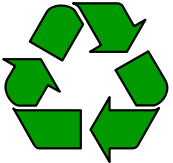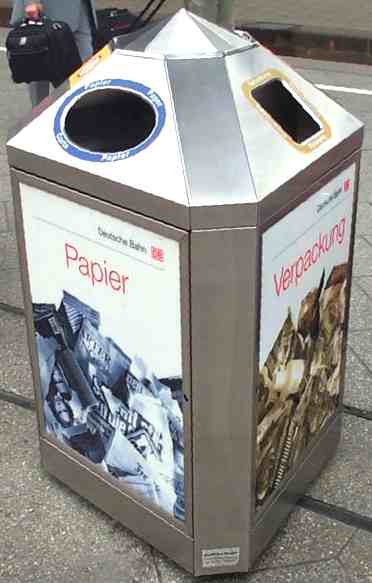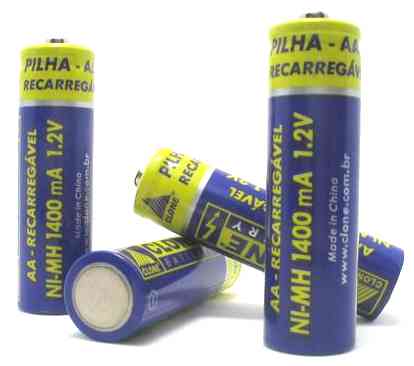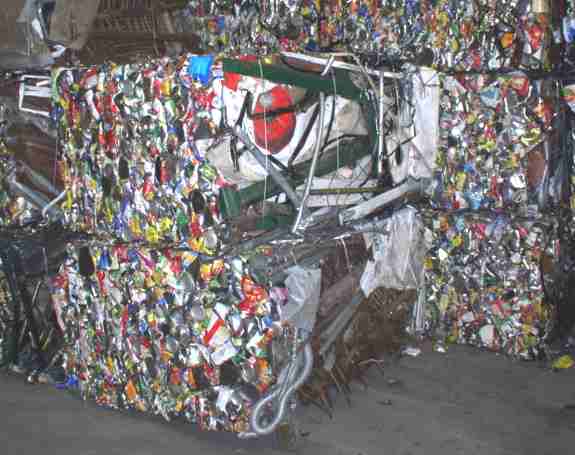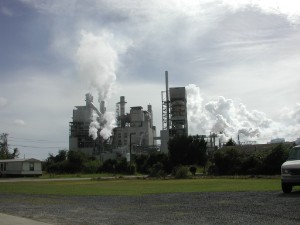|
RECYCLING
|
|||||||||
|
HOME | BIOLOGY | FILMS | GEOGRAPHY | HISTORY | INDEX | MUSIC | THE BOAT | SPORT | SPONSORS |
|||||||||
|
Recycling is the reprocessing of materials into new products. Recycling generally prevents the waste of potentially useful materials, reduces the consumption of raw materials and reduces energy usage, and hence greenhouse gas emissions, compared to virgin production. Recycling is a key concept of modern waste management and is the third component of the waste hierarchy.
Recyclable materials, also called "recyclables" or "recyclates", may originate from a wide range of sources including the home and industry. They include glass, paper, aluminium, asphalt, iron, textiles and plastics. Biodegradable waste, such as food waste or garden waste, is also recyclable with the assistance of micro-organisms through composting or anaerobic digestion.
Recyclates are sorted and separated into material types. Contamination of the recylates with other materials must be prevented to increase the recyclates' value and facilitate easier reprocessing for the ultimate recycling facility. This sorting can be performed either by the producer of the waste or within semi- or fully-automated materials recovery facilities.
There are two common household methods of recycling. In curbside collection (UK: kerbside collection), consumers leave presorted recyclable materials in front of their property to be collected by a recycling vehicle. With a "bring" or carry-in system, the householder takes the materials to collection points, such as transfer stations or civic amenity sites.
The term recycling does not generally include reuse, in which existing items are used for a new purpose.
History
Recycling has been a common practice throughout human history. In pre-industrial times, scrap made of bronze and other precious metals were collected in Europe and melted down for perpetual reuse, and in Britain dust and ash from wood and coal fires was downcycled as a base material in brick making. The main driver for these types of recycling was the economic advantage of obtaining recycled feedstock instead of acquiring virgin material, as well as a lack of public waste removal in ever more-populated sites.
Paper recycling began in Britain in 1921, when the British Waste Paper Association (now Confederation of Paper Industries) was established to encourage trade in waste paper recycling.
Resource shortages caused by the world wars, and other such world-changing occurrences greatly encouraged recycling. Massive government promotion campaigns were carried out in World War II in every country involved in the war, urging citizens to donate metals and conserve fiber, as a matter of significant patriotic importance. Resource conservation programs established during the war were continued in some countries without an abundance of natural resources, such as Japan, after the war ended.
The next big investment in recycling occurred in the 1970s, due to rising energy costs (recycling aluminum uses only 5% of the energy required by virgin production; glass, paper and metals have less dramatic but very significant energy savings when recycled feedstock is used. The passage of the Clean Water Act of 1977 in the USA created strong demand for bleached paper (office paper whose fibre has already been bleached white increased in value as water effluent became more expensive).
In 1973, the city of Berkeley, California began one of the first curbside collection programs with monthly pick ups of newspapers from residences. Since then several countries have started and expanded various doorstep collection schemes. Around this time, Woodbury, New Jersey was also a forerunner of the recycling industry in the United States, being the first in the state to mandate it.
In 1987, the Mobro 4000 barge hauled garbage from New York to North Carolina, where it had been denied. It was then sent to Belize, where it was denied as well. Finally, the barge returned to New York and the garbage was incinerated. The incident led to heated discussions about waste disposal and recycling.
One event that initiated recycling efforts occurred in 1989 when Berkeley banned the use of polystyrene packaging for keeping McDonald's hamburgers warm. One effect of this ban was to raise the ire of management at Dow Chemical, the world's largest manufacturer of polystyrene, which led to the first major effort to show that plastics can be recycled. By 1999, there were 1,677 companies in the USA alone involved in the post-consumer plastics recycling business.
Recycling and rubbish bin in a German railway station
Benefits
Recycling is beneficial in two ways: it reduces the inputs (energy and raw materials) to a production system and reduces the amount of waste produced for disposal.
A study conducted by the Technical University of Denmark found that in 80% of cases, recycling is the most efficient method to dispose of household waste.
Some materials like aluminum can be recycled indefinitely as there is no change to the materials. Other recycled materials like paper require a percentage of raw materials (wood fibers) to be added to compensate for the degradation of existing fibers. Recycling aluminium saves 95% of the energy cost of processing new aluminium because the melting temperature is reduced from 900 °C to 600 °C. It is by far the most efficient material to recycle. Recycling plastic saves 70% of the energy used in creating new plastic, and paper recycling saves 40% of the energy required to make a new product.
The resources being processed are purer, less energy is needed to process them and less energy is needed to transport from the place of extraction (e.g. bauxite/aluminium ore mines in Brazil or coniferous forests in Scandinavia).
This reduces the environmental, social, and usually the economic costs of manufacturing.
For example, bauxite mines in Brazil displace indigenous people, create noise pollution from blasting, machinery and transport, and create air pollution in the form of particulates (dust). The habitat loss and visual destruction is also negative both to the aesthetic qualities of the areas and the local environment. However, the mines do provide employment and revenue to the local population and economy, promoting development of the country as a whole.
The most commonly used methods for waste disposal (landfill, pyrolysis, incineration) may be environmentally damaging and unsustainable. Therefore any way to reduce the volume of waste being disposed in this fashion may be beneficial. The maximum environmental benefit is gained by waste minimization (reducing the amount of waste produced), and reusing items in their current form such as refilling bottles.
Drawbacks and criticism
All recycling techniques consume energy for transportation and processing and some also use considerable amounts of water, although recycling processes seldom amount to the level of resource use associated with raw materials processing.
There may also be drawbacks with the collection methods associated with recycling. Increasing collections of separated wastes adds to vehicle movements and the production of carbon dioxide. This may be negated however by centralized facilities such as some advanced material recovery facilities and mechanical biological treatment systems for the separation of mixed wastes.
Recycled materials also sometimes cost more financially than their non-recycled versions. This is not universal to every recycled product, but it does occur. Negative consequences from mercury recycling have been cited by The Wall Street Journal. The article traces mercury recovered from American recycling programs into sales of mercury for alluvial mining activities in Brazil. During the autumn of 2006, the European Union banned the export of liquid mercury, and a life-cycle analysis prior to institution of recycling programs may reduce the risk of unintended environmental consequences.
For some materials, recycling is more expensive than landfill disposal unless externalities are considered. For these products, there is an opportunity cost to recycling. Some argue that the financial costs of recycling some materials outweigh the environmental benefits. Some skeptics also argue that the environmental benefits of recycling do not compensate for the extra effort it may require.
According to an article in The New York Times by John Tierney, government mandated recycling wastes more resources than it saves. [1] Some highlights from the article:
Recycling techniques
Many different materials can be recycled but each type requires a different technique.
Aggregates & concrete
Concrete aggregate collected from demolition sites is put through a crushing machine, often along with asphalt, bricks, dirt, and rocks. Smaller pieces of concrete are used as gravel for new construction projects. Crushed recycled concrete can also be used as the dry aggregate for brand new concrete if it is free of contaminants. This reduces the need for other rocks to be dug up, which in turn saves trees and habitats.
Some batteries contain toxic heavy metals
Batteries
The large variation in size and type of batteries makes their recycling extremely difficult: they must first be sorted into similar kinds and each kind requires an individual recycling process. Additionally, older batteries contain mercury and cadmium, harmful materials which must be handled with care.
Lead-acid batteries, like those used in automobiles, are relatively easy to recycle and many new lead-acid batteries contain a high percentage of recycled material.
Biodegradable waste
Biodegradable waste can be recycled into useful material by biological decomposition. There are two mechanisms by which this can occur. The most common mechanism of recycling of household organic waste is home composting or municipal curbside collection of green wastes sent to large scale composting plants.
Alternatively organic waste can be converted into biogas and soil improver using anaerobic digestion. Here organic wastes are broken down by anaerobic microorganisms in biogas plants. The biogas can be converted into renewable electricity or burnt for environmentally friendly heating. Advanced technologies such as mechanical biological treatment are able to sort the recyclable elements of the waste out before biological treatment by either composting, anaerobic digestion or biodrying.
Electronics disassembly and reclamation
The direct disposal of electrical equipment such as old computers and mobile phones, is banned in many areas due to the toxic contents of certain components. The recycling process works by mechanically separating the metals, plastics and circuit boards contained in the appliance. When this is done on a large scale at an electronic waste recycling plant, component recovery can be achieved in a cost-effective manner.
Electronic devices, including audio-visual components (televisions, VCRs, stereo equipment), mobile phones and other hand-held devices, and computer components, contain valuable elements and substances suitable for reclamation, including lead, copper, and gold. They also contain a plethora of toxic substances, such as dioxins, PCBs, cadmium, chromium, radioactive isotopes, and mercury. Additionally, the processing required to reclaim the precious substances (including incineration and acid treatments) release, generate and synthesize further toxic by-products.
In the United States, an estimated 70% of heavy metals in landfills come from discarded electronics.Some regional governments are attempting to curtail the accumulation of electronics in landfills by passing laws obligating manufacturers and consumers to recycle these devices, but because in many cases safe dismantlement of these devices in accordance with first world safety standards is unprofitable, historically much of the electronic waste has been shipped to countries with lower or less rigorously-enforced safety protocols. Places like Guiyu, China dismantle tons of electronics every year, profiting from the sale of precious metals, but at the cost of the local environment and the health of its residents.
Mining to produce the same metals, to meet demand for finished products in the west, also occurs in the same countries, and the United Nations Conference on Trade and Development (UNCTAD) has recommended that restrictions against recycling exports be balanced against the environmental costs of recovering those materials from mining. Hard rock mining in the USA produces 45% of all toxics produced by all USA industries (2001 US EPA Toxics Release Inventory).
Printer ink cartridges & toners
Printer ink cartridges can be recycled. They are sorted into different brands and models which are then resold back to the companies that created these cartridges. The companies then refill the ink reservoir which can be sold back to consumers. Toner cartridges are recycled the same way as ink cartridges, using toner instead of ink. This method of recycling is highly efficient as there is no energy spent on melting and recreating the recycled object itself.
Steel crushed and baled for recycling at Ozark Adventist Academy
Ferrous metals
Iron and steel are the world's most recycled materials, and among the easiest materials to recycle, as they can be separated magnetically from the waste stream. Recycling is via a steelworks: scrap is either remelted in an Electric Arc Furnace (90-100% scrap), or used as part of the charge in a Basic Oxygen Furnace (around 25% scrap). Any grade of steel can be recycled to top quality new metal, with no 'downgrading' from prime to lower quality materials as steel is recycled repeatedly. 42% of crude steel produced is recycled material.
Non-ferrous metals
Aluminium is shredded and ground into small pieces or crushed into bales. These pieces or bales are melted in an aluminium smelter to produce molten aluminium. By this stage the recycled aluminium is indistinguishable from virgin aluminium and further processing is identical for both.
Due to the high melting point of aluminum ore, large amounts of energy are required to extract aluminum from ore, making the environmental benefits of recycling aluminium enormous. Approximately 5% of the CO2 is produced during the recycling process compared to producing raw aluminium (and an even smaller percentage when considering the complete cycle of mining and transporting the aluminium). Also, as open-cut mining most often used for obtaining aluminium ore, mining destroys large sections of natural land.
An aluminium can is 100% recyclable every time it is recycled, it saves enough energy to watch television for about three hours (compared to mining and producing a new can).
Glass waste collection point in a neighborhood area for separating clear, green and amber glass - bottle bank
Glass
Glass bottles and jars are accumulated via curbside collection schemes and bottle banks, where the glass may be sorted into color categories. The collected glass cullet is taken to a glass recycling plant where it is monitored for purity and contaminants are removed. The cullet is crushed and added to a raw material mix in a melting furnace. It is then mechanically blown or molded into new jars or bottles. Glass cullet is also used in the construction industry for aggregate and glassphalt. Glassphalt is a road-laying material which comprises around 30% recycled glass. Glass can be recycled indefinitely as its structure does not deteriorate when reprocessed.
Paper
Recycled paper is made from waste paper, usually mixed with fresh wood pulp. If the paper contains ink, it must be deinked. This also removes fillers, clays, and fiber fragments.
Almost all paper can be recycled today, but some types are harder to recycle than others. Kraft paper, papers coated with plastic or aluminum foil, and papers that are waxed, pasted, or gummed are usually not recycled because the process is too expensive. Gift wrap paper also cannot be recycled. Different types of paper are usually sorted before recycling, such as newspapers and cardboard boxes.
Different grades of paper are recycled into different types of new products. Old newspapers are usually made into new newsprint, egg cartons, or paperboard. Old corrugated boxes are made into new corrugated boxes or paperboard. High-grade white office paper can be made into almost any new paper product: stationery, newsprint, magazines, or books.
Sometimes recyclers ask for the removal of the glossy inserts from newspapers because they are a different type of paper. Glossy inserts have a heavy clay coating that some paper mills cannot accept. Since the paper is weighed down by the clay coating, a paper mill gets more recyclable fibers from a ton of pure newsprint.
Paper can only be recycled a finite number of times due to the shortening of paper fibers making the material less versatile. Often it will be mixed with a quantity of virgin material, referred to as downcycling. This does not however exclude the material from being used in other processes such as composting or anaerobic digestion, where further value can be extracted from the material in the form of compost or biogas.
Plastic
Plastic recycling is the process of recovering scrap or waste plastics and reprocessing the material into useful products. Compared to glass or metallic materials, plastic poses unique challenges - because of the massive number of types of plastic, they each carry a resin identification code, and must be sorted before they can be recycled. This can be costly - while metals can be sorted using electromagnets, no such 'easy sorting' capability exists for plastics. In addition to this, while labels do not need to be removed from bottles for recycling, lids are often made from a different kind of non-recyclable plastic.
Plastics recycling rates lag far behind those of other items, such as newspaper and aluminium; consumers are typically unsure of how to recycle plastics, and compared to paper and metals fewer recycling facilities exist.
Kraft international paper company mill
Textiles
When considering textile recycling one must understand what the material consists of. Most textiles are composites of cotton (biodegradable material) and synthetic plastics. The textile's composition will affect its durability and method of recycling.
Workers sort and separate collected textiles into good quality clothing and shoes which can be reused or worn. There is a trend of moving these facilities from developed countries to developing countries.
Damaged textiles are further sorted into grades to make industrial wiping cloths and for use in paper manufacture or material suitable for fibre reclamation and filling products. If textile reprocessors receive wet or soiled clothes however, these may still be disposed of in a landfill, as the washing and drying facilities are not present at sorting units.
Fibre reclamation mills sort textiles according to fibre type and colour. Colour sorting eliminates the need to re-dye the recycled textiles. The textiles are shredded into "shoddy" fibres and blended with other selected fibres, depending on the intended end use of the recycled yarn. The blended mixture is carded to clean and mix the fibres and spun ready for weaving or knitting. The fibres can also be compressed for mattress production. Textiles sent to the flocking industry are shredded to make filling material for car insulation, roofing felts, loudspeaker cones, panel linings and furniture padding.
Timber
Recycling timber has become popular due to its image as an environmentally friendly product, with consumers commonly believing that by purchasing recycled wood the demand for green timber will fall and ultimately benefit the environment. Greenpeace also view recycled timber as an environmentally friendly product, citing it as the most preferable timber source on their website. The arrival of recycled timber as a construction product has been important in both raising industry and consumer awareness towards deforestation and promoting timber mills to adopt more environmentally friendly practices.
Other Techniques
Several other materials are also commonly recycled, frequently at an industrial level. Ship breaking, which is associated with local environmental, health, and safety risks, and represents an environmental justice problem. Tires are also commonly recycled. Used tires can be added to asphault, producing road surfaces that are more durable, create less traffic noise, and absorb precipitation better than traditional asphault. Automobiles and metal scavenge are also recycled at an industrial scale.
LINKS and REFERENCES
World leaders need constant support from the electorate if they are to put corrective policies in place. Help us to remind your local representative by supporting our high profile mission.
MORE ON AGENDA 21 MEMBERS OF PARLIAMENT A-Z HOUSE OF LORDS A-Z COUNCIL'S AGENDA 21
A taste for adventure capitalists
Solar Cola - a healthier alternative
|
|||||||||
|
This
website
is Copyright © 1999 & 2007 NJK. The bird |
|||||||||
|
AUTOMOTIVE | BLUEBIRD | ELECTRIC CARS | ELECTRIC CYCLES | SOLAR CARS |
